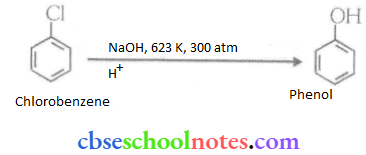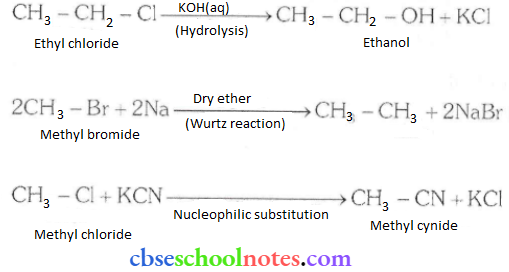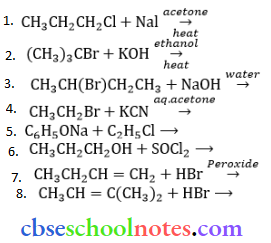Haloalkanes And Haloarenes
Question 1. Write The structure of the following compounds:
- 2-Cliloro-3-methylpentane
- 1-Chloro-4-methylcyclohexane
- 4-terl. ButyI-3-iodohcplane
- 1, 4-DibmmobiU-2- one
- 1-Bromo-4-sec, butyl-2-melhylbenzene
Answer:

Question 2. Draw the structure of major monohalo products in each of the following reactions:
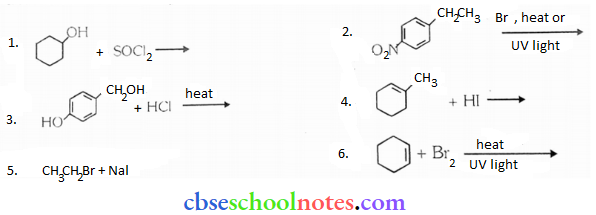
Answer:

Question 3. Arrange each set of increasing boiling points.
- Bromomethane, Bromoform, Chloromethane, Dibromethane.
- 1-chloride, Isopropyl chloride, 1-chlorobutane.
Answer:

Read and Learn More Class 12 Chemistry with Answers Chapter Wise
Question 4. Which alkyl halide from the following pairs would you accept to react more rapidly by an SN2 mechanism? Explain your answer.

Answer:

Question 5. In the following pairs of halogen compounds, which compound undergoes a faster SN1 reaction?
![]()
Answer:
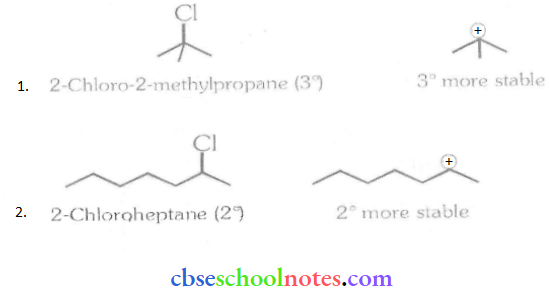

Question 6. Identify A, B, C, D, E, R, and R1 in the following:
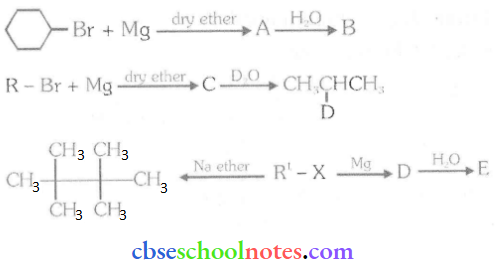
Answer:
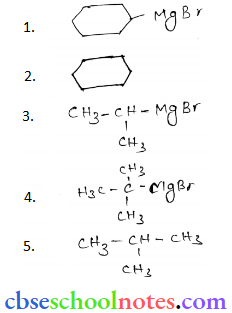
Question 7. Write the IUPAC name of the following:

Answer:
- 4-Bromopent-2-ene
- 3-Bromo-2-methylbut-1-ene
- 4-Bromo-3-methyl pent-2-ene
- 1-Bromo-2-methylbut-2-ene
- 1-Bromobut-2-ene
- 3-Bromo-2-methylpropene
Question 8. Write the product of the following reactions:
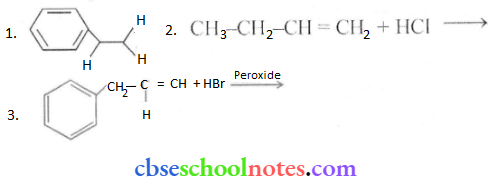
Answer:

Question 9. Haloalkanes react with KCN to form alkyl cyanides as the main product while AgCN forms isocyanides as the chief product. Explain.
Answer:
- KCN is predominantly ionic and provides cyanide ions in solution. Although both carbon and nitrogen atoms are in a position to donate electron pairs, the attack place mainly through the carbon atom and not through the nitrogen atom since the C-C bond is more stable than the C-N bond.
- However, AgCN is mainly covalent in nature and nitrogen is free to donate electron pair forming isocyanide as the main product.
Question 10. In the following pairs of hydrogen compounds, which would undergo SN2 reaction faster?
![]()
Answer:

- It is a primary halide and therefore undergoes SN2 reaction faster.
- As iodine is a better-leaving group because of its large size, it will be released at a faster rate in the presence of income nucleophiles.
Question 11. Predict the order of reactivity of the following compounds in SN1 and SN2 reactions:
- The four isomeric bromobutan.es
- C6H5CH2Br, C6H5CH(C6H5)BR, C6H5CH(CH3)Br, C6H5C(CH3)(C6H5)Br
⇒ \(\mathrm{CH}_3 \mathrm{CH}_2 \mathrm{CH}_2 \mathrm{CH}_2 \mathrm{Br}<\left(\mathrm{CH}_3\right)_2 \mathrm{CHCH}_2 \mathrm{Br}<\mathrm{CH}_3 \mathrm{CH}_2 \mathrm{CH}(\mathrm{Br}) \mathrm{CH}_3<\left(\mathrm{CH}_3\right)_3 \mathrm{CBr}\left(\mathrm{SN}_{\mathrm{N}} 1\right)\)
⇒ \(\mathrm{CH}_3 \mathrm{CH}_2 \mathrm{CH}_2 \mathrm{CH}_2 \mathrm{Br}>\left(\mathrm{CH}_3\right)_2 \mathrm{CHCH}_2 \mathrm{Br}>\mathrm{CH}_3 \mathrm{CH}_2 \mathrm{CH}\left(\mathrm{Br}_2 \mathrm{CH}_3>\left(\mathrm{CH}_3\right)_3 \mathrm{CBr}\left(\mathrm{S}_{\mathrm{N}} 2\right)\right.\)
Question 12. Although chlorine is an electron-withdrawing group, yet it is ortho-, para-directing in electrophilic aromatic substitution reactions. Why?
Answer: Reactivity is thus controlled by the stronger inductive effect and orientation is controlled by resonance effect.
Question 13. Name the following halides according to the IUPAC system and classify them as alkyl, alkyl, benzene(primary, secondary, tertiary), vinyl, or aryl halide:
- \(\left(\mathrm{CH}_3\right)_2 \mathrm{CHCH}(\mathrm{Cl}) \mathrm{CH}_3\)
- \(\mathrm{CH}_3 \mathrm{CH}_2 \mathrm{CH}\left(\mathrm{CH}_3\right) \mathrm{CH}\left(\mathrm{C}_2 \mathrm{H}_5\right) \mathrm{Cl}\)
- \(\mathrm{CH}_3 \mathrm{CH}_2 \mathrm{C}\left(\mathrm{CH}_3\right)_2 \mathrm{CH}_2 \mathrm{I}\)
- \(\left(\mathrm{CH}_3\right)_3 \mathrm{CCH}_2 \mathrm{CH}(\mathrm{Br}) \mathrm{C}_6 \mathrm{H}_5\)
- \(\mathrm{CH}_3 \mathrm{CH}\left(\mathrm{CH}_3\right) \mathrm{CH}(\mathrm{Br}) \mathrm{CH}_3\)
- \(\mathrm{CH}_3 \mathrm{C}\left(\mathrm{C}_2 \mathrm{H}_5\right)_2 \mathrm{CH}_2 \mathrm{Br}\)
- \(\mathrm{CH}_3 \mathrm{C}(\mathrm{Cl})\left(\mathrm{C}_2 \mathrm{H}_5\right) \mathrm{CH}_2 \mathrm{CH}_3\)
- \(\mathrm{CH}_3 \mathrm{CH}=\mathrm{C}(\mathrm{Cl}) \mathrm{CH}_2 \mathrm{CH}\left(\mathrm{CH}_3\right)_2\)
- \(\mathrm{CH}_3 \mathrm{CH}=\mathrm{CHC}(\mathrm{Br})\left(\mathrm{CH}_3\right)_2\)
- \(\mathrm{p}-\mathrm{ClC}_6 \mathrm{H}_4 \mathrm{CH}_2 \mathrm{CH}\left(\mathrm{CH}_3\right)_2\)
- \(\mathrm{m}-\mathrm{ClCH}_2 \mathrm{C}_6 \mathrm{H}_4 \mathrm{CH}_2 \mathrm{C}\left(\mathrm{CH}_3\right)_3\)
- \(\mathrm{O}-\mathrm{Br}-\mathrm{C}_6 \mathrm{H}_4 \mathrm{CH}\left(\mathrm{CH}_3\right) \mathrm{CH}_2 \mathrm{CH}_3\)
Answer:

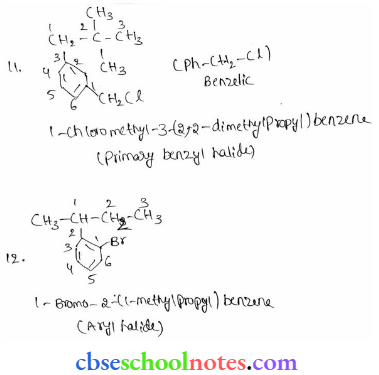
Question 14. Give the IUPAC names of the following compounds
- \(\mathrm{CH}_3 \mathrm{CH}(\mathrm{Cl}) \mathrm{CH}(\mathrm{Br}) \mathrm{CH}_3\)
- \(\mathrm{CHF}_2 \mathrm{CBrClF}\)
- \(\mathrm{ClCH}_2 \mathrm{C} \equiv \mathrm{CCH}_2 \mathrm{Br}\)
- \(\left(\mathrm{CCl}_3\right)_3 \mathrm{CCl}\)
- \(\mathrm{CH}_3 \mathrm{C}\left(\mathrm{p}-\mathrm{ClC}_6 \mathrm{H}_4\right)_2 \mathrm{CH}(\mathrm{Br}) \mathrm{CH}_3\)
- \(\left(\mathrm{CH}_3\right)_3 \mathrm{CCH}=\mathrm{CClC}_6 \mathrm{H}_4 \mathrm{I}-\mathrm{p}\)
Answer:


Question 15. Write the structures of the following organic halogen compounds.
- 2-Chloro-3-methyl pentane
- p-Bromochlorobenzene
- l-Chloro-4-ethylcyelohexane
- 2-(2-Chlorophenyl)-1-iodooctane
- 2-Bromobutane
- 4-tert-butyl-3-iodoheptane
- 1-Bromo-4-sec-butyl-2-methyl benzene
- 1,4-Dibromobut-2-ene
Answer:
2-Chloro-3-methyl pentane![]()
p-Bromochlorobenzene![]()
1-Chloro-4-ethylcyclohexane
2-(2-ChlorophenyI)-1-idodooctane
2-Bromobutane CH
4-Tert-butyl-3-iodoheptane
1-Bromo-4-sec-butyl-2-methyl benzene
1,4-Dibromobut-2-ene
Question 16. Which of the following has the highest dipole moment?
- CH2Cl2
- CHCl3
- CCl4
Answer:

CCl4 < CHCl3 < CH2Cl2
Question 17. A hydrocarbon C5H10 does not react with chlorine in the dark but gives a single monochrome compound C5H9Cl in bright sunlight. Identify the hydrocarbon.
Answer:

The reactions involved in the question are:
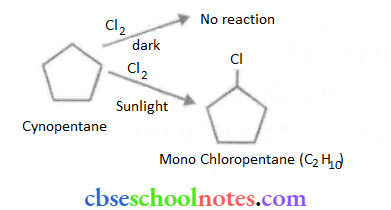
Question 18. Write the isomers of the compound having the formula C4H9Br.
Answer: There are four isomers of the compound having the formula Chi I- Hr. These isomers are given below.

7. Write the equations for the preparation of 1-iodobutane from
- 1-butanol
- 1-chlorobutane
- but-1-ene
Answer:


Question 19. What are ambident nucleophiles? Explain with an example.
Answer: Ambident nucleophiles are nucleophiles having two nucleophilic sites. For example, nitrite ion is an ambident nucleophile.
![]()
Question 20. Which compound in each of the following pairs will react faster in SN2 reaction with Oil?
- CH3Br or CH3I
- (CH3)3CCl or CH3Cl
Answer: CH3-I is more reactive because I+ is a better-leaving group than Br+

In the case of (CH3)3CCl. the attack of the nucleophile at the carbon atom is hindered by the presence of bulk)- substituents on that carbon atom bearing the leaving group.
Question 21. Predict all the alkanes that would be formed by dehydrohalogenation of the following halides with sodium ethoxide in ethanol and identify the major alkene.
- 1-Brorao-1-methylcyclohexane
- 2-Chloro-2-methyl butane
- 2,2, 3-Trirpethyl-3-bromopentane
Answer:
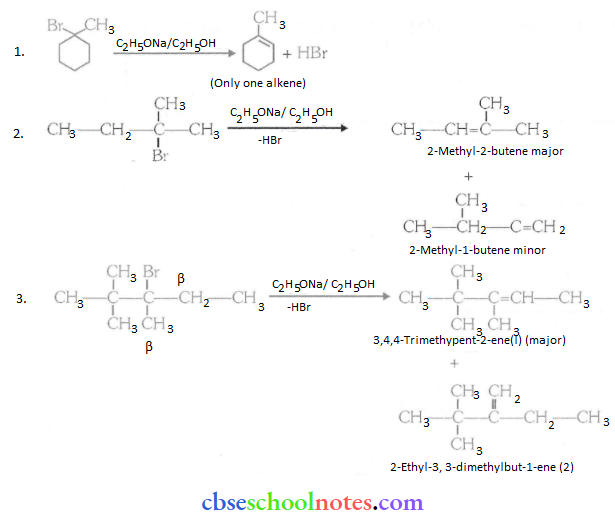
Question 22. How will you bring about the following conversion?
- Ethanol to but-1-yne
- Ethane to broiuoethene
- Propene to I-nitropropane
- Toluene to benzyl alcohol
- Propene to propyne
- Ethanol to ethyl fluoride
- Bromomethane to propanone
- But-1-cue to but-2-ene
- 1-Chlorobutane to n-octane
- Benzene to biphenyl
Answer:

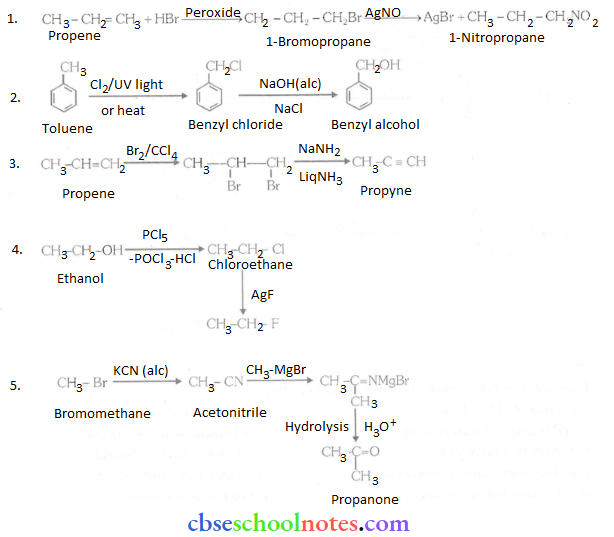
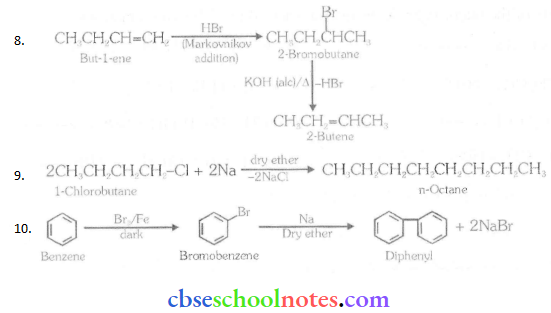
Question 23. Explain why
- The dipole moment of chlorobenzene is lower than that of cyclohexyl chloride?
- Alkyl halides, though polar, are immiscible with water?
- Grignard reagents should be prepared under anhydrous conditions.
Answer:

+M of -Cl and I of -Cl are in opposite directions so the dipole moment is decreased in chlorobenzene.
- No H-bonding of halide with water.
- Grignard reagents in the presence of moisture, react with H2O to give alkanes.

Question 24. Give the uses of freon 12. DDT, carbon tetrachloride, and iodoform.
Answer:
- Uses of Freon-12 Freon-12 (dichlorodifluoromethane. CF2Cl2) is commonly known as CFC. It is used as a refrigerant in refrigerators and air conditioners.
- The use of DDT (p-p-dichlorodiphenyltrichloroethane) is one of the best-known insecticides.
Uses of carbonletrachloride (CCI4)
- It is used for manufacturing refrigerants and propellants for aerosol cans.
- It is used as a solvent in the manufacture of pharmaceutical products.
- It is used as a fire extinguisher.
Uses of iodoform (CHI3) Iodoform was used earlier as an antiseptic. The antiseptic property of iodoform is due to the liberation of free iodine when it comes in contact with the skin.
Question 25. Write the structure of the major organic product in each of the following reactions.
Answer:
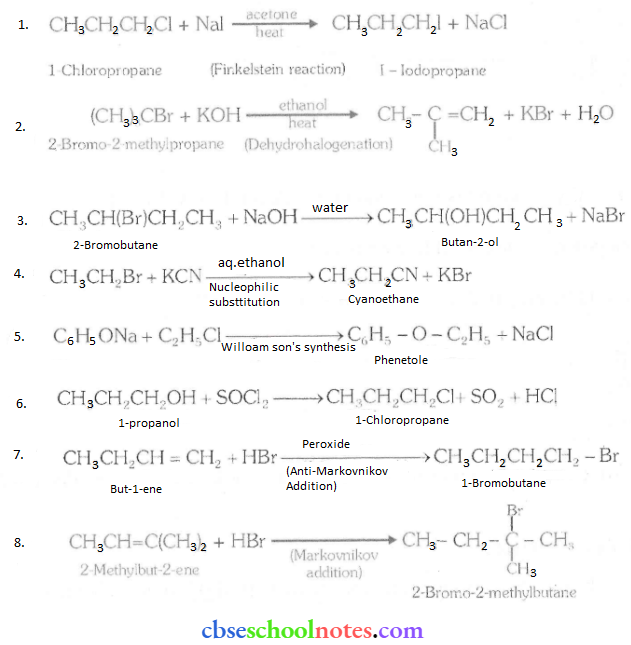
Question 26. Write the mechanism of the following reaction:
![]()
Answer: The given reaction is:
![]()
The given reaction is an SN2 reaction. In this reaction. CM acts as the nucleophile and attacks the carbon atom to which Br is attached. CN ion is an ambident nucleophile and can attack through both C and N. In this case, it attacks through the C-atom.
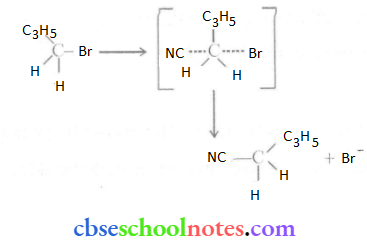
Question 27. Arrange the compounds of each set in order of reactivity towards SN2 displacement:
- 2-Bromo-2-metln Ihutane. 1-Bromopentane, 2-Bromopentane
- 1-Bromo-3-methyl butane.2-Bromo-2-methyl butane.3-Bromo-2-inethyIhutane
- 1-Bromobutane. l-Bromo-2. 2-dimethyIpropane. 1-Bromo-2-methylbutane. 1-Bromo 3-methyIhutane
Answer:
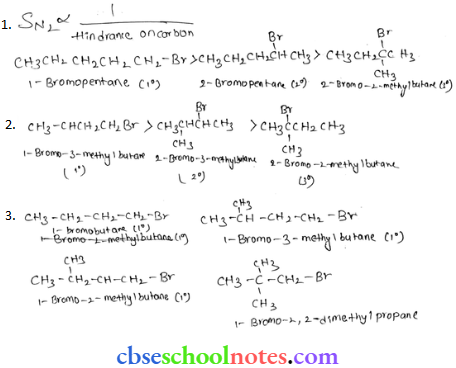
(more branching at a nearer distance)
Hence, the increasing order of reactivity of the given compounds towards SN2 is:
1-Bromo-2,2-dimethy Ipropane < 1-Bromo-2-methy Ihutane < 1-Bromo-3-methylbutane < 1-Bromobutane.
Question 28. Out of C6H5CH2Cl and C6H5CHClC6H5, which is more easily hydrolyzed by aqueous KOH?
Answer: C6H5CHClC6H5 (more reactive)

(more stable intermediate)
Question 29. p-Dichlorobenzene has higher m.p. and lower solubility than those of o-and m-isomers. Discuss.
Answer:
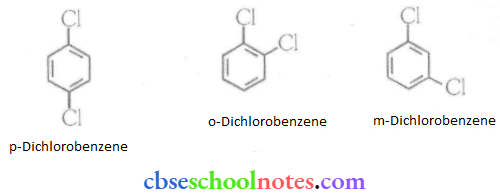
p-Dichlorobenzene is more symmetrical than o-and m-isomers. For this reason, molecules of p-dichlorobenzene are more closely than o-and m-isomers in the crystal lattice. Therefore, more energy is required to break the crystal lattice of p-dichlorobenzene.
Question 30. How the following conversions can be carried out?
- Propene to propane-1-ol
- Ethanol to but-1-yne
- 1-Bromopropane to 2-bromopropane
- Toluene to benzyl alcohol
- Benzene to 4-bronitobenzene
- Benzyl alcohol to 2-phenylethanoid acid
- Ethanol to propane nitrile
- Aniline to chloro benzene
- 2-Chlorobutane to 3, 4-dimethyl hexane
- 2-Methyl-1-propane to 2-chloro-2-methyl propane
- Ethyl chloride to propanoic acid
- But-1-ene to n-butyliodide
- 2-chloropropane to 1-propanol
- Isopropyl alcohol to iodoform
- Chlorobenzene to p-nitrophenol
- 2-Bromopropane to 1-bromopropane
- Chloroethane to butane
- Benzene to diphene
- tert-Butyl bromide to isobutyl bromide
- Aniline to phenyl isocyanide
Answer:

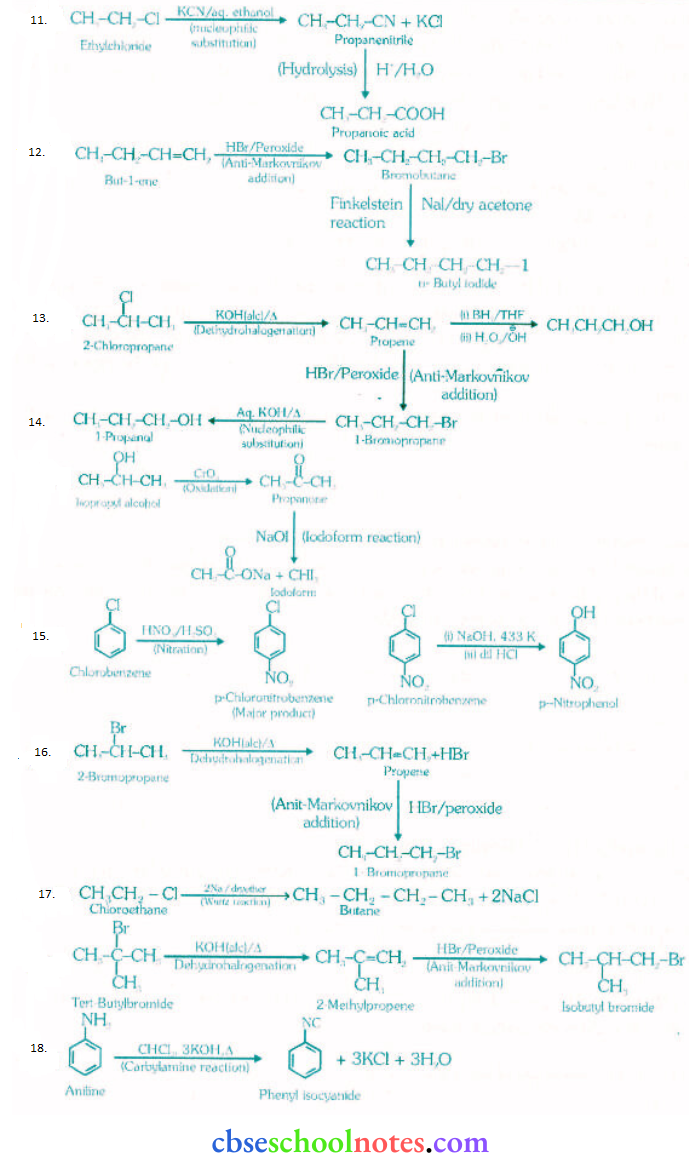
Question 31. The treatment of alkyl chlorides with aqueous KOH leads to the formation of alcohols but in the presence of alcoholic KOH, alkenes are major products, Explain.
Answer:
OH– ion is highly solvated in an aqueous solution and as a result, the basic character of OH– ion decreases. Therefore, it cannot abstract hydrogen from the β-carbon. So
⇒ \(\mathrm{R}-\mathrm{Cl}+\mathrm{Aq} \cdot \mathrm{KOH} \longrightarrow \mathrm{R}-\mathrm{OH}+\mathrm{KCl}\)
On the other hand, an alcoholic solution of KOFI contains an alkoxide (RO–) ion. which is a strong base. Thus, it can abstract hydrogen from the β-carbon of the alkyl chloride and form an alkene by eliminating a molecule of HCl.
![]()
Question 32. Primary alkyl halide C4H9Br(a) reacted with alcoholic KOH to given compound (b). Compound (b) is reacted with lIBr to give (c) which is an isomer of (a). When (a) is reacted with sodium metal it gives compound (d). C8H18 which is different from the compound formed when n-butyl bromide is reacted with sodium. Give the structural formula of (a) and write the equations for all the reactions.
Answer:
Two primary alkyl halides have the formula. C4H9Br. They are n-butyl bromide and isobutyl bromide.

Therefore, compound (a) is either n-butyl bromide or isobutyl bromide.
Now, compound (a) reacts with Na metal to give compound (h) of molecular formula. C8H18. Which is different from the compound formed when n-butyl bromide reacts with Na metal. Hence. compound (a) must be isobutyl bromide.
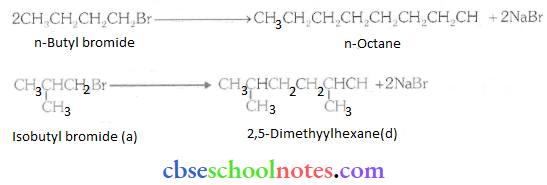
Thus, compound (d) is 2. 5-Dimethylhexane.
It is given that compound (a) reacts with alcoholic KOH to give compound (b). compound (b) is 2-methyl propene.

Also, compound (b) reacts with HBr to give compound (c) which is an isomer of (a). Hence compound (e) is -2-Bromo-2-methy propane.

Question 33. What happens when
- n-butyl chloride is treated with alcoholic KOH?
- Broinohen/ene is treated with Mg in the presence of dry ether.
- Chlorobenzene is subjected to hydrolysis.
- Ethyl chloride is treated with aqueous KOH.
- Methyl bromide is treated with sodium in the presence of dry ether.
- Methyl chloride is treated with KCN.
Answer:
![]()
Chlorobenzene does not undergo hydrolysis under normal conditions. However, it undergoes hydrolysis when heated in an aqueous sodium hydroxide solution at a temperature of 623 K and a pressure of 300 atm to form phenol.
